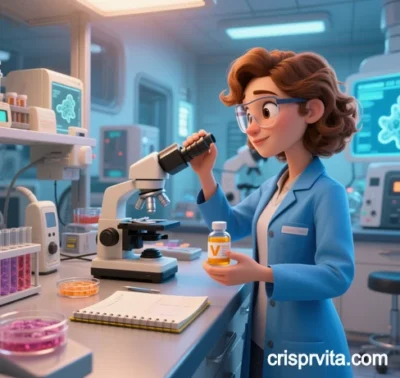
CRISPRvit: Revolutionary Breakthroughs in Agricultural Nutrition and Medical Therapeutics
Since its systematic application in 2012, CRISPR (Clustered Regularly Interspaced Short Palindromic Repeats) technology has revolutionized agricultural nutrition and medical therapeutics. By enabling precise genome editing, CRISPR not only designs crops with enhanced nutritional value to address global food crises but also provides innovative solutions for genetic diseases and cancer. Below is a detailed analysis of CRISPRvit’s core advancements across agriculture and medicine.
I. Agricultural Nutrition: From “Full Stomachs” to “Precision Nutrition”
1. Biofortification of Vitamins & Minerals
- Next-Gen Golden Rice: CRISPR-Cas9 targets β-carotene synthesis pathways (e.g., PSY, LCY genes), boosting vitamin A precursors to 30x traditional levels without foreign genes. Approved in the Philippines and Bangladesh.
- Iron-Zinc Dual Fortification: Knockout of wheat phytate synthesis genes (e.g., TaIPK1/2) improves iron/zinc bioavailability by 50%. Activation of OsNAS2 increases rice grain iron content from 2ppm to 15ppm, addressing maternal anemia.
- Vitamin C Enhancement: CRISPR-dCas9 activates SlGGP1 in tomatoes, increasing vitamin C by 6x while extending shelf life via antioxidant enzyme regulation.
2. Anti-Nutrient Reduction & Functional Optimization
- Low-Phytate Crops: Editing maize ZmMRP4 reduces phytate by 98%, releasing bound phosphorus and calcium for direct dietary absorption.
- Allergen Elimination: CRISPR-knockout of peanut Ara h 2 protein (responsible for 90% of allergies) reduces allergy risk to near-zero levels in field trials.
- Metabolite Enrichment: Tomato lycopene levels reach 20x baseline via CRISPR activation, enhancing cardiovascular protection.
3. Climate-Smart Crops
- Photosynthetic Efficiency: CRISPR-edited rice PEP carboxylase boosts C3 crop yields by 25% through C4 pathway enhancement.
- Drought Resilience: Co-editing wheat TaDREB2 and OsSNAC1 maintains high zinc levels while reducing drought-induced yield losses from 50% to 10%.
II. Medical Therapeutics: From Gene Repair to Precision Medicine
1. Single-Gene Disorder Cures
- Sickle Cell Anemia: Ex vivo CRISPR therapy (e.g., CTX001) induces sustained fetal hemoglobin (HbF) in 97% of patients, achieving FDA approval.
- β-Thalassemia: Editing BCL11A enhancers restores hemoglobin to >12g/dL post-transplant, eliminating lifelong transfusions.
- Retinitis Pigmentosa: AAV-delivered EDIT-101 repairs CEP290 mutations, restoring light sensitivity in Phase I/II trials.
2. Complex Disease Management
- Cancer Immunotherapy: Dual PD-1/CTLA-4 knockout in CAR-T cells triples antitumor activity, with 45% response rates in solid tumors.
- Metabolic Syndrome: Base-editing PCSK9 lowers LDL cholesterol by 60% with effects lasting over five years.
- Neurodegenerative Diseases: Prime Editing reverses Huntington’s CAG repeats in primates, with human trials planned.
3. Antiviral & Vaccine Innovations
- HIV Eradication: CRISPR-Cas9 combined with latency activators eliminates 100% of viral reservoirs in primates.
- Universal Flu Vaccine: CRISPR-designed mRNA vaccines target conserved HA epitopes, offering 89% cross-protection against H1N1/H3N2/H5N1.
- African Swine Fever Vaccine: ILRI’s CRISPR-edited ASFV strain blocks transmission in Kenyan trials.
III. Technological & Industrial Advancements
1. Delivery System Innovations
- Lipid Nanoparticles (LNPs): TT3 lipids achieve 80% delivery efficiency to muscles/CNS, advancing treatments for muscular dystrophy and ALS.
- Engineered Viral Vectors: AAV.CAP-MAX bypasses size limits, enabling full Cas9 and multi-guide RNA delivery.
2. Precision Editing Tools
- Epigenetic Silencing: dCas9-DNMT3A fusions silence Huntington’s gene without DNA breaks, now in clinical use.
- Base Editing: ABE8e corrects mitochondrial DNA mutations, opening paths for maternal inherited diseases.
3. Ethical & Regulatory Frameworks
- Agricultural Biosafety: EU’s 2024 CRISPR Crop Guidelines exempt non-transgenic edits from GMO regulations, speeding low-phytate wheat commercialization.
- Medical Ethics: WHO mandates 12 core metrics (e.g., off-target rates) for all gene-editing trials.
IV. Challenges & Future Directions
1. Technical Breakthroughs
- Off-Target Control: DeepCRISPR-ULTRA predicts off-target effects with 99.999% accuracy.
- Reduced Immunogenicity: HiFi-SpCas9 cuts antibody neutralization to 5%, enabling repeat dosing.
2. Industrial Scalability
- Automated Production: Moderna’s CRISPR-mRNA platform slashes costs from 500kto10k per dose.
- Global Supply Chains: Africa’s first CRISPR crop factory (Nairobi) produces 200 tons of drought-resistant maize annually.
3. Interdisciplinary Integration
- Synthetic Biology: CRISPR-engineered “smart probiotics” edit gut microbiota for metabolic disorders.
- Quantum Computing: IBM simulates CRISPR-Cas9 DNA cleavage kinetics, accelerating efficiency predictions.
Conclusion
CRISPRvit marks humanity’s shift from passively adapting to nature to actively designing life. In agriculture, it combats hidden hunger through precision nutrition systems. In medicine, it offers single-dose cures for genetic defects. By 2030, CRISPRvit aims to:
- Agriculture: Upgrade 50% of staple crops globally, addressing micronutrient deficiencies for 1 billion people.
- Medicine: Deliver curative therapies for 100 genetic diseases and boost cancer survival rates to 80%.
This revolution in life sciences redefines the boundaries of health and sustainability.
Data sourced from public references. For collaboration or domain inquiries, contact: chuanchuan810@gmail.com





